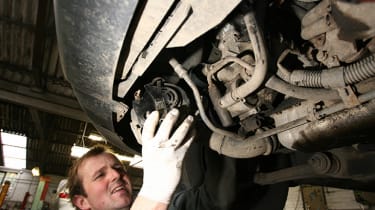What is a car’s head gasket?
We describe the function of a head gasket and how to detect if it has blown

Though cars are a major part of our everyday lives, the inner workings of an engine may as well be the result of magic as far as most are concerned. As their name suggests, combustion engines work by compressing a mixture of air and fuel to create miniature explosions. This process, while tried and refined over the last century, can still be relatively dangerous, and an engine must be designed to keep each volatile substance used for combustion separated.

A head gasket sits on top of the engine block, sandwiched between it and the cylinder head. Its main function is to maintain the necessary pressure for combustion and to prevent oil from spilling out of the bores and mixing with coolant fluid, which would cause the engine to overheat. It does this by creating an airtight seal which will keep the gases and fluids inside the engine and thus, working smoothly.
What are the signs of a blown head gasket?
Continual exposure to excessive heat may cause a head gasket to warp and eventually blow. While this may sound like a very small part of the engine to go wrong, its effects can easily be detected behind the wheel. Signs of a blown head gasket include:
- High engine temperature: usually indicated by a warning light on the dashboard, high engine temperatures can be caused by engine coolant leaking due to the broken gasket seal
- A loss of power: the reduction in pressure within the engine block will make the engine less responsive
- White exhaust smoke: leaking engine coolant could find its way into the engine, igniting and creating thick, white smoke
- White, milky oil: use a dipstick to check your car’s oil. If it comes out coated in a white milky solution, almost like mayonnaise, engine coolant may have leaked into and contaminated the oil pan
If you detect one of these issues, we advise taking your car to the nearest service centre as soon as possible. An overheating engine can be dangerous, plus the leaking fluids can cause costly damage to the rest of your car’s powertrain. If left untreated, a blown head gasket can result in terminal engine damage.
How much does a blown head gasket cost to fix?
Unfortunately, a blown head gasket will not be good news for your wallet. While the head gasket itself is a relatively inexpensive part, the repair process involves the disassembly of your car's engine. This is a complex and lengthy job, plus it can also uncover other gremlins and parts that need repairing or replacing.
Repairing a head gasket typically starts from around £500, though this can be significantly more depending on the complexity and extent of the damage caused. A good, reputable repair centre should be able to easily source a suitable replacement part and, if no other damage is caused, get you back on the road in a couple of days.

For drivers needing a quick fix, there is also the option of applying gasket sealer. This is a sticky, viscous liquid that can be poured into your car’s radiator. With the engine running, the sealant will flow into your car's engine, ultimately filling the holes created by the damaged head gasket. A bottle of gasket sealer typically costs around £50.
While its low cost may seem appealing, we recommend steering clear of gasket sealer and taking your car to get repaired properly. Sealer is only a temporary solution to the problem and failure to address the damage fully could lead to further, more significant issues down the line.
Car technology made simple
- Car cameras: how cameras are making cars safer
- Dash cams: what are they and how do they work?
- What is cruise control and adaptive cruise control?
- Electronic handbrakes and Auto-hold: a complete guide
- What is a car immobiliser and does my car have one?
- What is Alcantara?
- What is kerbweight?
- What is a space saver wheel?
- What is regenerative braking?
- What is gross vehicle weight?
- What is bluetooth?
- What are spark plugs and glow plugs?
- What are brake pads and discs?
- What is a supercharger?
- What is lumbar support?
- What is air suspension, and how does it work?
- What are adaptive dampers, and how do they work?
- What is keyless entry and keyless start?
- eCall explained
- What is a head-up display?
- What is Waze?
- What is Mirrorlink?
- What is what3words?
- Car lights and headlights: complete guide
Recommended

In-car safety assistance systems leaving drivers confused and dissatisfied

What is Android Auto? Apps, music and new gaming features
Most Popular
Tips & advice

Car dashboard warning lights: what does each symbol mean?

Electric car charging stations: public networks, charger types, apps and maps








